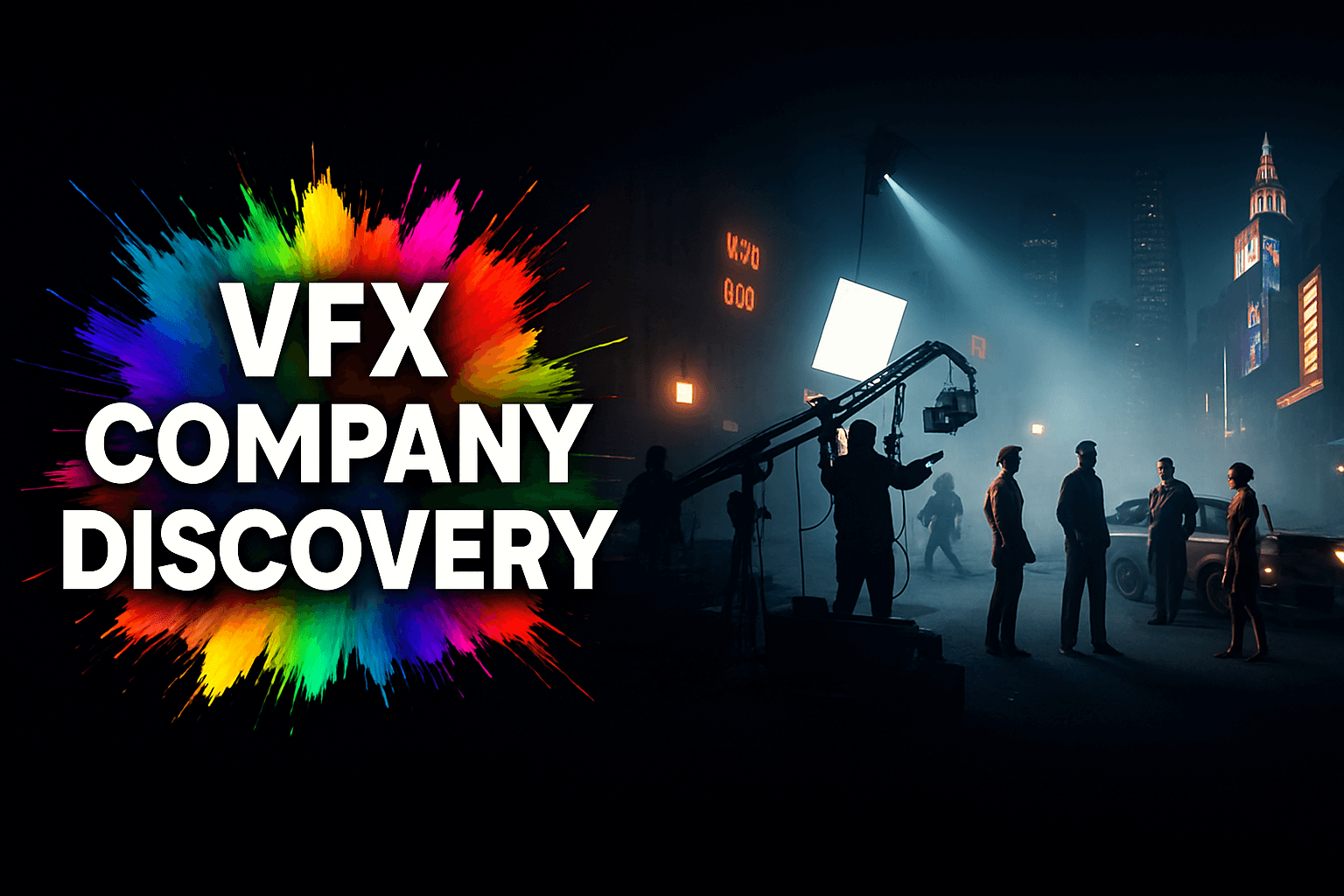VFX Company Discovery: How to Strategically Source Partners for Film and TV Projects

Introduction
The global entertainment market is in constant motion, driven by an unyielding demand for high-quality, visually stunning content. For executives in film and television, sourcing the right partners for this journey is a mission-critical task.
The visual effects (VFX) market, valued at over $11 billion and projected to grow, is a crucial component of this ecosystem. However, navigating this fragmented landscape to find a suitable partner for VFX production is a complex undertaking.
This process of VFX company discovery goes beyond a simple search. It requires a strategic approach that evaluates a studio’s capabilities, track record, and specific expertise. A misstep can lead to budget overruns, missed deadlines, and a compromised creative vision.
This guide provides a strategic framework for identifying, vetting, and ultimately, selecting the ideal VFX partner for your next project.
Key Takeaways
| Core Challenge | Sourcing and vetting the ideal VFX partner is a fragmented, time-consuming, and high-risk process. |
| Strategic Solution | Implement a data-driven, systematic approach to discover and qualify potential VFX studios globally. |
| Vitrina’s Role | Vitrina provides the real-time intelligence and verified data required to streamline the entire VFX partner discovery workflow. |
The Challenge of Modern VFX Company Discovery
For entertainment executives, finding a high-quality VFX studio is a critical first step in a project’s post-production lifecycle. Yet, the traditional methods for VFX company discovery are often inefficient and opaque.
A quick online search can yield a vast, unorganized list of companies, but it reveals little about their true capabilities, project history, or financial stability. Executives are left to manually sift through portfolios, outdated websites, and disparate industry articles to construct a basic profile of a potential vendor.
This process is complicated by several factors. The first is market fragmentation. The VFX landscape is a mix of a few major, multinational players and a vast number of smaller, highly specialized boutique studios.
Without a centralized database, it is nearly impossible to maintain a comprehensive view of who does what, where they are located, and which projects they have recently completed.
Second, there is a distinct lack of actionable data. Executives need to know more than just a company’s name. They require details about the company’s specific expertise (e.g., character animation, CGI environments, motion capture), their history of collaboration with certain studios or genres, and their track record of delivering on time and on budget. Gathering this intelligence manually through a series of calls and fragmented searches is a time-intensive effort.
Third, the risk of a misaligned partnership is high. Selecting the wrong VFX studio can lead to significant production delays, creative compromises, and cost overruns.
A studio might specialize in one area but lack the talent for another. A firm that delivered on a major blockbuster may not be the right fit for a smaller, niche television series.
The risk is compounded when exploring international options, which can introduce additional complexities related to communication, time zones, and data security. According to an article from GUVI, tight deadlines, budget constraints, and globalization are among the key challenges facing the VFX industry today.
The Strategic Framework for Vetting VFX Partners
To move past the inefficiencies of traditional sourcing, a strategic, data-driven framework is essential. This approach breaks down the discovery process into a series of repeatable, verifiable steps.
Step 1: Define Your Core Needs and Scope
Before engaging in any search, precisely define the project’s VFX requirements. This includes not only the number of shots and overall budget but also the specific nature of the work, such as whether the project is a stylized animated series or a photorealistic sci-fi feature.
It’s also important to identify if you require specific services like creature animation, complex fluid simulations, or real-time virtual production, and to set clear key milestones and delivery dates.
By creating a detailed needs analysis, you can filter potential partners based on a clear set of criteria, eliminating those without the right specialization or capacity from the outset.
Step 2: Source a Global Pool of Candidates
Relying on a limited network or a simple search for “VFX companies near me” is a costly mistake. The global entertainment supply chain offers access to a diverse talent pool with varying specializations and cost structures.
A strategic approach requires casting a wide net to source potential vendors from key hubs like London, Vancouver, Mumbai, and Seoul. A systematic, centralized database that profiles these companies is a vital tool for this initial phase.
Step 3: Evaluate & Qualify Against a Standardized Scorecard
Once you have a list of potential VFX studios, the next step is to evaluate them based on a standardized set of criteria. This vetting process must go deeper than just their demo reel.
I recommend a scorecard that includes a complete, verified list of their past projects, including their specific role and contribution, and which studios or production houses they frequently collaborate with, as this can indicate trust and reliability.
It should also detail the names and roles of the key creative leads, producers, and supervisors, as well as a detailed list of their technical skills and software proficiencies.
This scorecard provides a quantitative way to compare and rank different companies, ensuring the decision is based on verifiable data rather than subjective impressions.
Sourcing and Vetting in a Global Market
The globalization of the entertainment supply chain has opened up new opportunities but has also introduced new complexities. While an increasing number of projects are being produced internationally to take advantage of tax incentives and specialized talent, this multi-geography model requires an even more rigorous approach to partner discovery.
When considering a VFX studio in a different country, executives must evaluate factors that go beyond creative talent. Time zone differences, communication barriers, and data security protocols become paramount.
A production in the United States, for example, must be able to seamlessly coordinate with a post-production house in Europe.
This demands a proactive vetting process that assesses a partner’s logistical capabilities, not just their creative portfolio. Furthermore, a company’s financial stability and operational health are key considerations, particularly for long-term projects.
A partner’s track record of successful deliveries, their corporate ownership, and their public reputation are all indicators of reliability. Without a centralized resource to verify this information, an executive risks entering into a high-stakes partnership with an incomplete picture.
How Vitrina Transforms VFX Company Discovery
Vitrina was specifically designed to solve the very challenges of VFX company discovery and vendor sourcing. The platform’s core value proposition is to replace the manual, fragmented search with a single, intelligent source of truth for the entire entertainment supply chain.
Vitrina operates as a global B2B search engine and intelligence platform. It provides a comprehensive, verified database of companies, projects, and executives that enables a strategic, data-driven approach to sourcing.
Vitrina’s platform goes beyond a simple directory by mapping and verifying over 1.2 million film and TV projects and the 168,000+ companies and over 3 million executives involved in their creation.
This allows executives to see a full, verified profile of a VFX company, including a list of every project they have contributed to, their specific role on each, and their collaboration history. Instead of a generic keyword search, users can find partners based on highly specific criteria.
This includes filtering by location, production type (e.g., live-action, animation), specialization, and even by the projects they have worked on. This functionality allows you to find a company that has worked on a film similar to yours in both genre and scale.
Vitrina’s intelligence extends to the project level, so an executive can search for a specific film or TV series and instantly see every company and person who worked on it, from the VFX studio to the sound designer. This provides a level of insight that is impossible to achieve with manual research.
By using Vitrina, executives can reduce the time and resources spent on sourcing and vetting by up to 90%, allowing them to focus on what matters: making a high-quality creative product.
For an executive, this means moving from a reactive, opaque search to a proactive, transparent discovery process. You can explore how Vitrina helps find partners for projects in various stages, from development to post-production, on their solutions page.
Conclusion: A Data-First Approach to VFX Partnerships
In an industry where every detail matters, a strategic approach to VFX company discovery is no longer a luxury—it is a necessity. The process must evolve from an ad-hoc, manual search to a systematic, data-driven workflow.
By defining clear requirements, leveraging comprehensive intelligence, and vetting partners against objective criteria, executives can mitigate risk and ensure their creative vision is brought to life by the right team.
The future of content creation belongs to those who can master not only the art of storytelling but also the science of supply chain intelligence.
Frequently Asked Questions
A visual effects (VFX) company is a specialized studio that uses digital technology to create, manipulate, or enhance imagery for film, television, and other media. This includes a wide range of services such as computer-generated imagery (CGI), motion capture, compositing, and digital matte painting.
VFX companies typically get involved during the pre-production or production phases to plan out complex shots and sequences. Their primary work is done during post-production, where they integrate digital elements with live-action footage to create the final visual product.
VFX companies offer services that range from basic tasks like rig removal and wire cleanup to highly complex work such as full-CGI environments, digital characters, and large-scale destruction simulations. Many companies specialize in a specific niche or genre.
This depends entirely on the project’s needs. Large studios can handle bigger projects with significant resource requirements, while smaller boutiques may offer more specialized expertise and a more personalized approach. It is crucial to match the studio’s capacity and expertise to the scale and complexity of your project.















































